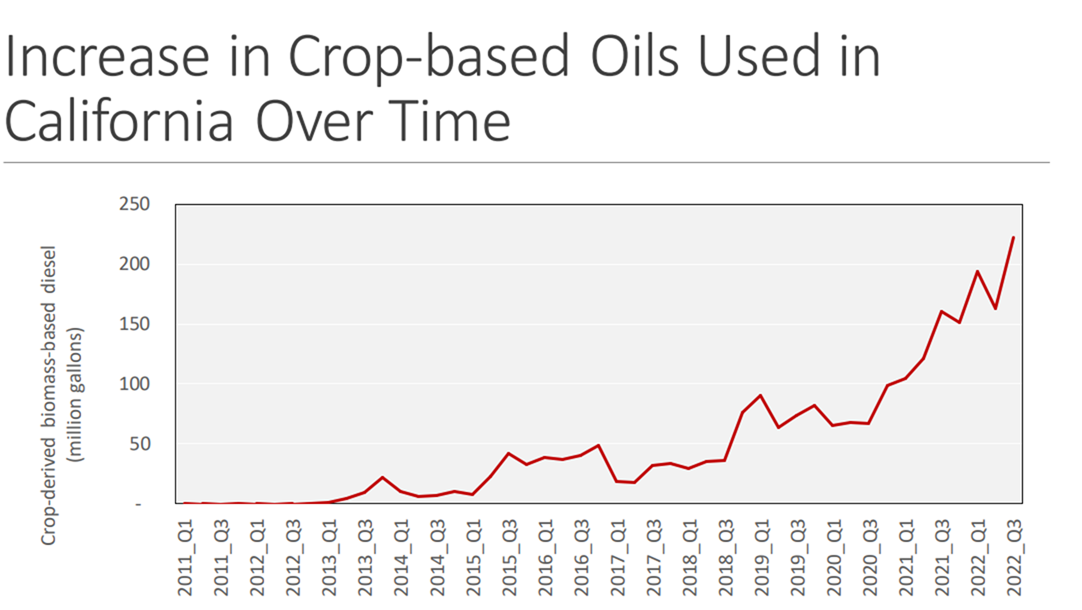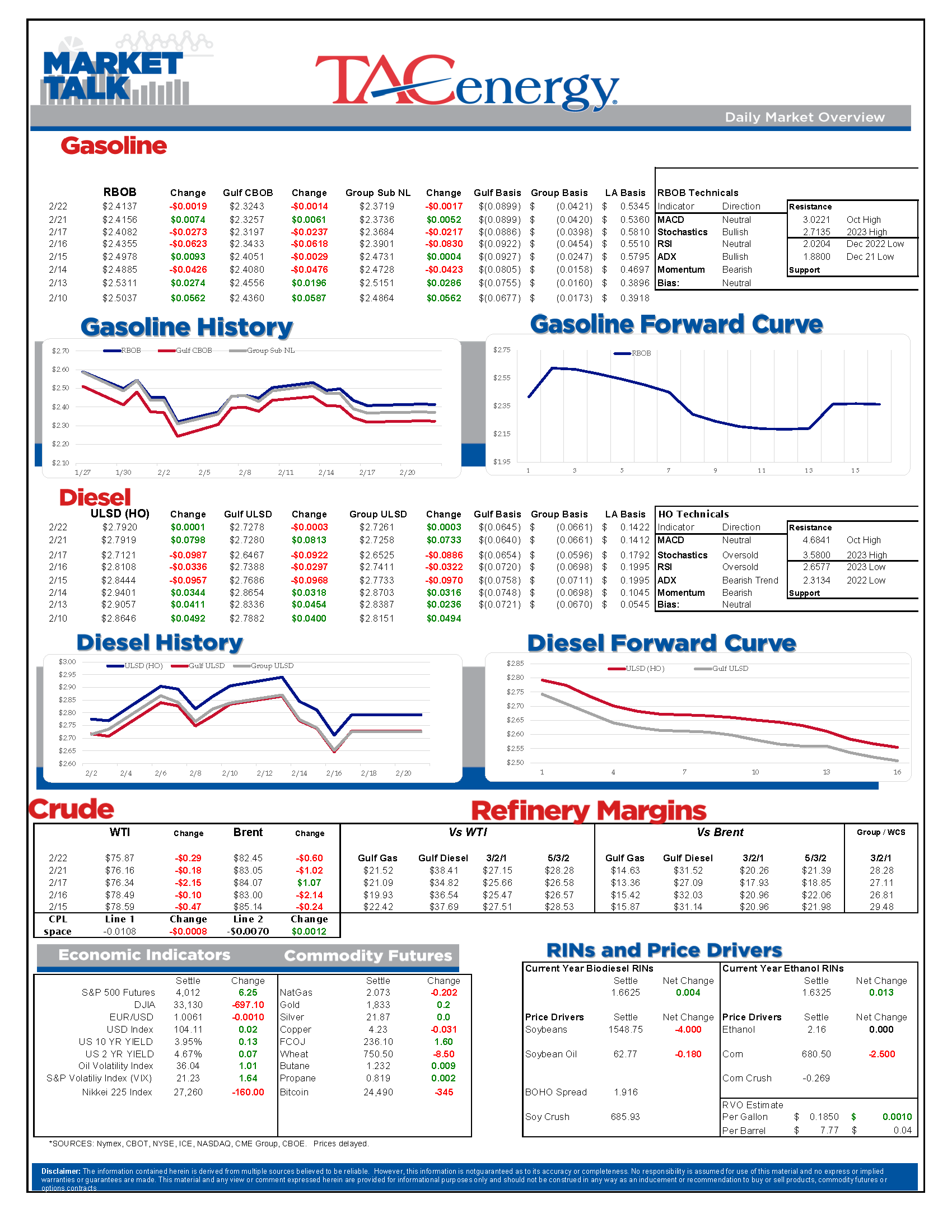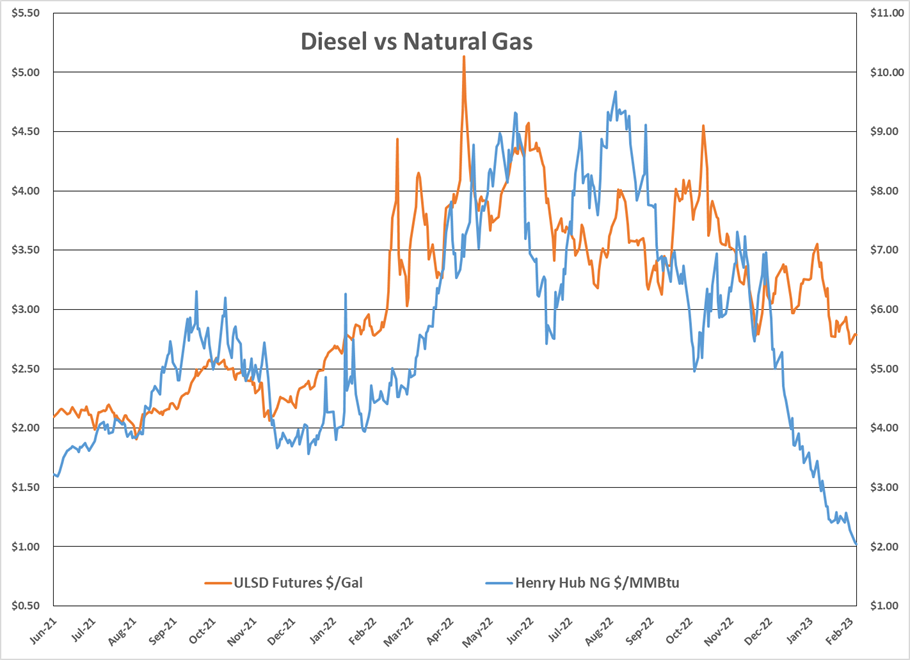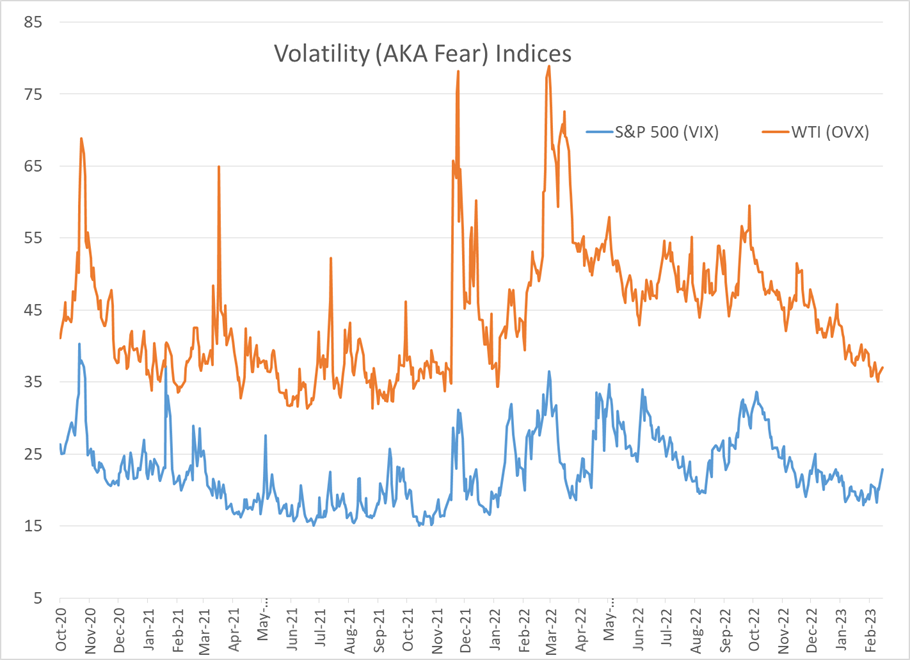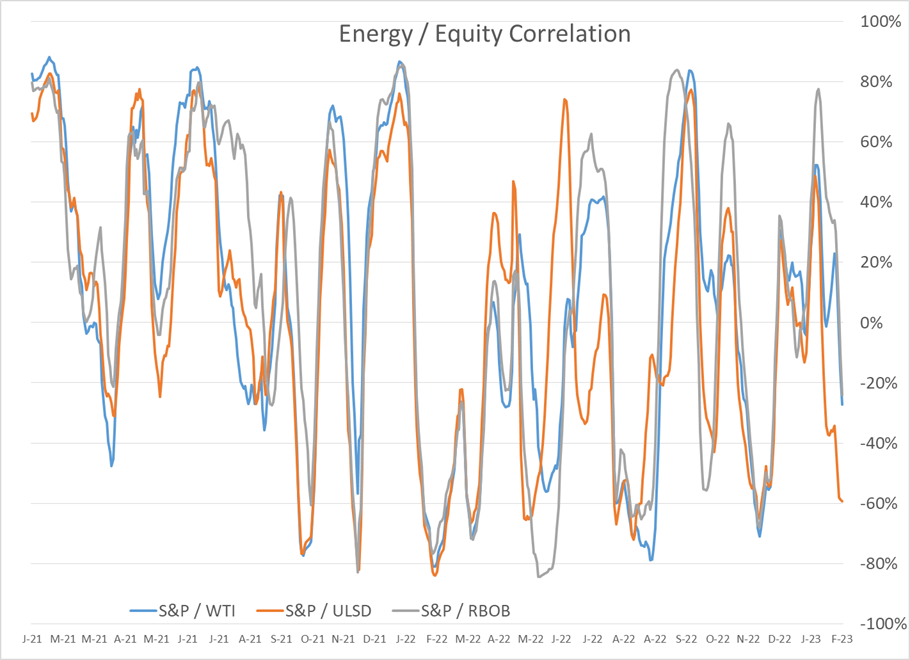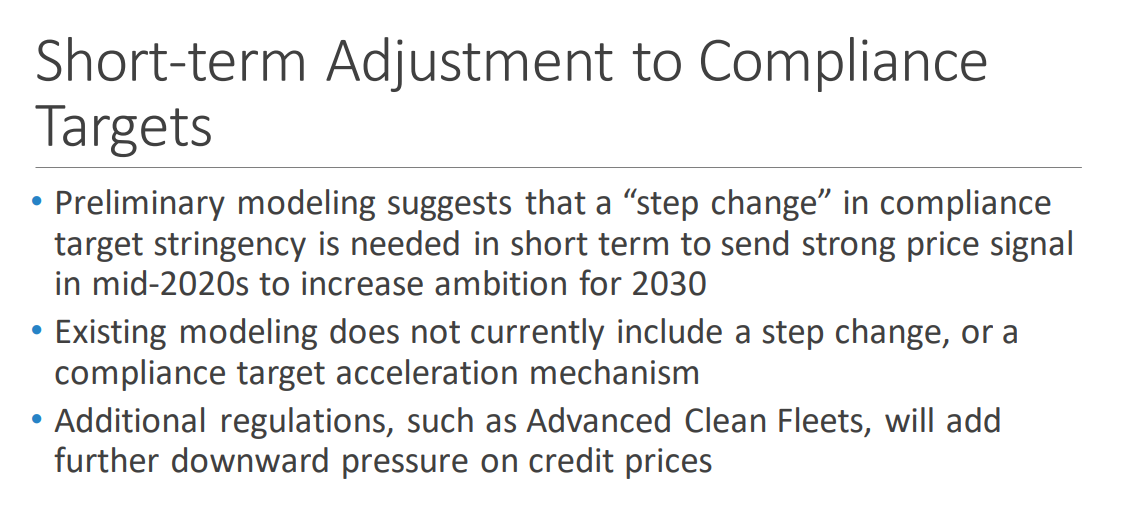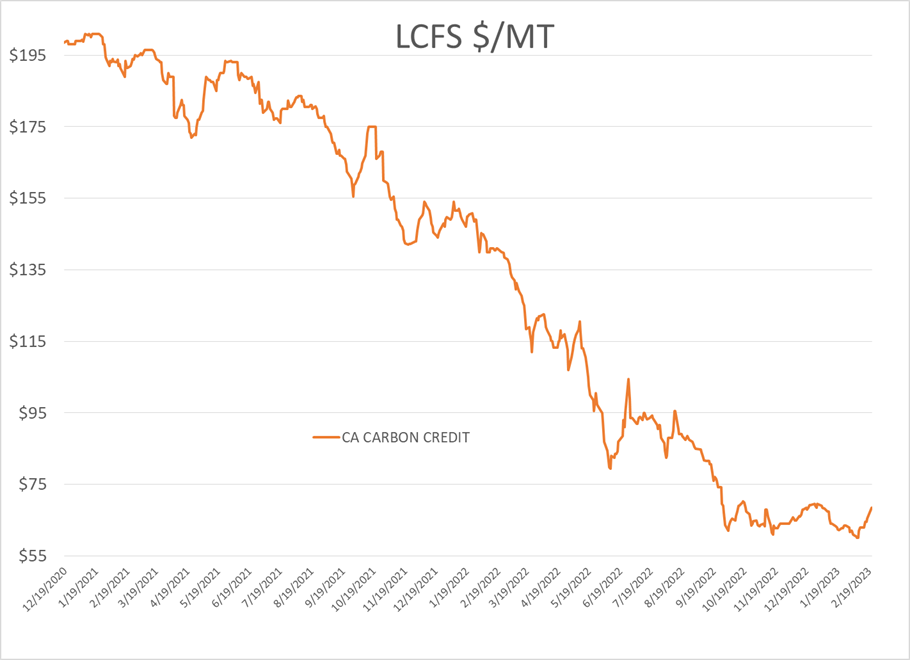Energy Futures Buck Sinking Equities, OVX Drops To Yearly Low

It’s a quiet start for energy markets Wednesday with gasoline and diesel prices hovering around break even for the day following a strong recovery rally in diesel prices Tuesday that earned back nearly half of last week’s heavy losses.
Refined products continue to shrug off moves in equity markets, with a 2% drop in US stock indices doing little to slow the bounce in refined product prices Tuesday. It’s also worth noting that the oil volatility index (OVX) reached its lowest level since January of 2022 last week, even as stocks are seeing a tick higher in their volatility readings (VIX).
A new report suggests that European refinery runs reached their highest levels since the start of COVID in January, which no doubt played a role in the substantial pullback in crack spreads we’ve seen in the past several weeks. The big question now is whether or not those plants can maintain that level of run rate, or if it was a short-term acceleration in preparation for the Russian diesel embargo. Speaking of which, a Reuters report today highlights how traders continue to get creative with their boats to bypass sanctions.
Freeport reported it had received regulatory approval to restart commercial activities at its LNG facility that has been offline for nearly 8 months due to a fire. That facility is the 2nd largest in the US, and accounted for more than 10% of export volumes, so should help alleviate some of the domestic glut of supplies that have pushed Natural gas futures below $2 for the first time since September of 2020.
California’s Air Resources Board (CARB) is holding a public workshop today to discuss potential regulation amendments. The slide deck published ahead of that meeting suggests the agency is pushing for a “step change” in carbon intensity targets to boost LCFS credit prices and “increase ambition for 2030”. LCFS values rallied to a 6 week high following that report, although they remain at just a fraction of the value we saw 2 years ago…which is why the agency seems to see the need to change target reduction levels to prop up those prices. The slide deck also suggests the agency is looking to add intrastate Jet Fuel usage to the LCFS program, and phase out some forms of renewables, like RNG (aka biomethane).
Click here to download a PDF of today's TACenergy Market Talk.
News & Views
View All
Energy Futures Are Caught Up In Headline Tug-O-War This Morning
Energy futures are caught up in headline tug-o-war this morning with Canadian oil production concerns and a positive US GDP report trying to push prices higher while sinking Chinese demand worries and Gaza ceasefire hopes are applying downward pressure. The latter two seem to be favored more so far this morning with WTI and Brent crude oil futures down ~45 cents per barrel, while gasoline and diesel prices are down about half a cent and two cents, respectively.
No news is good news? Chicago gasoline prices dropped nearly 30 cents yesterday, despite there not being any update on Exxon’s Joliet refinery after further damage was discovered Wednesday. Its tough to say if traders have realized the supply situation isn’t as bad as originally thought or if this historically volatile market is just being itself (aka ‘Chicago being Chicago’).
The rain isn’t letting up along the Texas Gulf Coast today and is forecasted to carry on through the weekend. While much of the greater Houston area is under flood watch, only two refineries are within the (more serious) flood warning area: Marathon’s Galveston Bay and Valero’s Texas City refineries. However, notification that more work is needed at Phillip’s 66 Borger refinery (up in the panhandle) is the only filing we’ve seen come through the TECQ, so far.
Premiums over the tariff on Colonial’s Line 1 (aka linespace value) returned to zero yesterday, and actually traded in the negatives, after its extended run of positive values atypical of this time of year. Line 1’s counterpart, Line 2, which carries distillates from Houston to Greensboro NC, has traded at a discount so far this year, due to the healthy, if not over-, supply of diesel along the eastern seaboard.
Click here to download a PDF of today's TACenergy Market Talk.

WTI And Brent Crude Oil Futures Are Trading ~$1.50 Per Barrel Lower In Pre-Market Trading
The across-the-board drawdown in national energy stockpiles, as reported by the Department of Energy yesterday, stoked bullish sentiment Wednesday and prompt month gasoline, diesel, and crude oil futures published gains on the day. Those gains are being given back this morning.
The surprise rate cut by the People’s Bank of China is being blamed for the selling we are seeing in energy markets this morning. While the interest rate drop in both short- and medium-term loans won’t likely affect energy prices outright, the concern lies in the overall economic health of the world’s second largest economy and crude oil consumer. Prompt month WTI and Brent crude oil futures are trading ~$1.50 per barrel lower in pre-market trading, gasoline and diesel are following suit, shaving off .0400-.0450 per gallon.
Chicagoland RBOB has maintained its 60-cent premium over New York prices through this morning and shows no sign of coming down any time soon. Quite the opposite in fact: the storm damage, which knocked Exxon Mobil’s Joliet refinery offline on 7/15, seems to be more extensive than initially thought, potentially extending the repair time and pushing back the expected return date.
There are three main refineries that feed the Chicago market, the impact from one of them shutting down abruptly can be seen in the charts derived from aforementioned data published by the DOE. Refinery throughput in PADD 2 dropped 183,000 barrels per day, driving gasoline stockpiles in the area down to a new 5-year seasonal low.
While it seems all is quiet on the Atlantic front (for now), America’s Refineryland is forecasted to receive non-stop rain and thunderstorms for the next four days. While it may not be as dramatic as a hurricane, flooding and power outages can shut down refineries, and cities for that matter, all the same, as we learned from Beryl.

